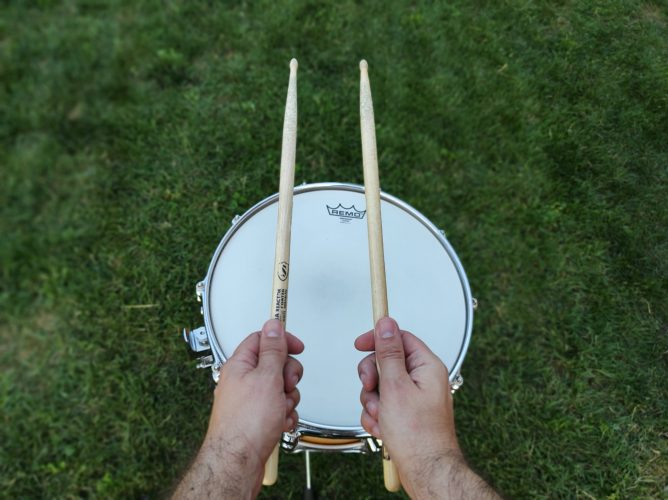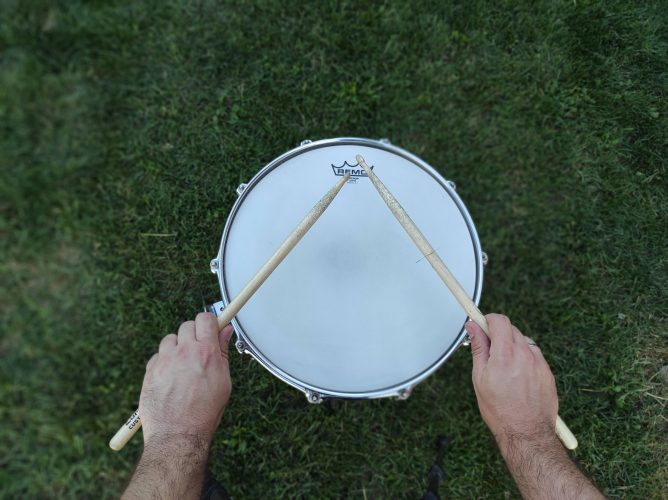Whether you are new to drumming or just want to improve your technique, it’s important to learn to hold the drumsticks properly.
There are two main ways how to hold drumsticks: traditional and matched grip, along with matched grip variations such as french, german, and american grip.
In this article, we will explain how to use each grip and the advantages or disadvantages of different grips.
You can try out and see which grip suits you the best or combine them regarding your needs.
Let’s dig into the most common grips drummers use and the proper way to do it.
Traditional grip

In the traditional grip, each hand holds the stick differently.
Let’s see how to play a traditional grip step by step.
Step 1
Position your left (or weaker) hand with your palm facing inward, as you would shake somebody’s hand.
Place the drumstick between your thumb and index finger, and then bend your ring and pinky fingers down, placing the stick between your middle and ring finger.
This kind of grip is called “underhand grip.”
Step 2
Put your right (or leading) hand with the palm facing inward, and take the drumstick.
The thumb of the leading hand will go on top of the drumstick, while the rest of the fingers will support the stick from the bottom.
This grip is also known as “overhand grip.”
Step 3
Try to get the stick’s rebound to find the best balance position where it bounces the most.
Practice full strokes in this position by rotating your forearm like you are spinning a doorknob.
When you find the balance point, you will be able to bounce the stick with control over a rebound without the stick sliding up or down.
Step 4
Once you get your stick moving, bounce it with your thumb without moving the forearm.
Try bouncing the stick, playing quarter notes along with a metronome, slowly speeding up the tempo.
Pros
- Traditional grip is beneficial to learn since it provides a sound ideal for performing rudimental drumming patterns like in jazz music.
- You can easily vary the angle of the drumstick’s hit on the drums.
- It’s easier to produce double or multiple bounces with the left hand since the weight of the hand is mostly under the stick, allowing the response to happen easily.
Cons
- It can take a long time to build equivalent strength and endurance in both hands.
- The left underhand grip uses fewer muscles than the right overhand grip, and this causes each muscle to do a larger percentage of the work.
- It’s harder to move around and play different drums.
Matched grip

Here is how you can play matched grip:
Step 1
Place your hands in front of you with palms facing down.
Step 2
Put the sticks in the middle of your hands, placing them between the ring finger, thumb, and middle finger.
Step 3
Both hands take the overhead position, with thumbs on top of the drumstick and the rest of the fingers supporting the stick from the bottom.
Pros
- It gives us more control over the stick and takes less power because you will use less effort from the fingers than with a traditional grip.
- Strokes are more powerful and efficient to move around the kit.
- The weaker hand can emulate what the dominant hand is doing because the sticks are held in a similar position in both hands.
Cons
- It’s less suited to jazz music than traditional drip.
- If you’re playing cross-handed on the hi-hat, it can prevent you from playing full strokes.
French grip

One of the variations of the matched grip is the french grip, and here is how you can do it:
- Place your drumsticks in the matched grip position, turn your palms upward, and ensure that your thumbs point up to the sky.
- The palms of the hands face directly toward each other, and the stick is moved primarily with the fingers rather than the wrist.
- The pressing point is between the thumb and index finger.
- Avoid wrist motion while playing to minimize muscular tension and keep all rotation in the elbow.
Purpose
French grip allows drummers to reach speeds that would be harder to reach with any other type of grip.
You will be mastering finger control and taking full advantage of it.
German grip

If you wonder how to play german grip, here are the first steps:
- Start with holding your drumsticks at the balance point with your index finger and thumb and the rest of the fingers placed under the stick.
- Palms are facing down, parallel to the drumhead or other playing surface.
- You should form a 90-degree angle with the sticks when looking top-down and use outwards and inwards motion to hit a drum.
- The stick is moved primarily with the wrist.
Purpose
The german grip is the best grip for slow tempos because you wil have great wrist control.
Compared to other variations of matched grips, it is the most powerful grip.
American grip

To play american grip, start with these steps:
- Place the stick between the thumb and the index finger’s first joint, and close the rest of the fingers loosely around the stick.
- Put your sticks on the snare drum with the back of your hand at a 45-degree angle.
- Instead of the outwards-inwards, you will use up-down movements when hitting the drum.
Purpose
In the american grip, the power goes from the whole arm instead of a wrist, so you have a lot more energy available.
This grip utilizes the fingers, wrist, and arm in equal measure.
Conclusion
Drummers use two main grips: traditional and matched grip, or some of the variations of the matched grip such as french, german, or american.
You can choose the way how to hold your drumsticks and combine different grips according to their purposes.
And remember, the good grip is the foundation of your drumming.
As famous drummer Thomas Lang jokingly says in this article: get a grip!
